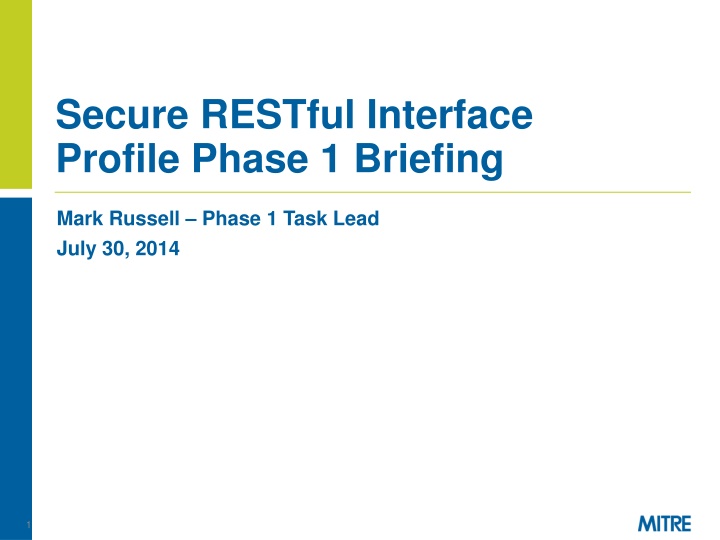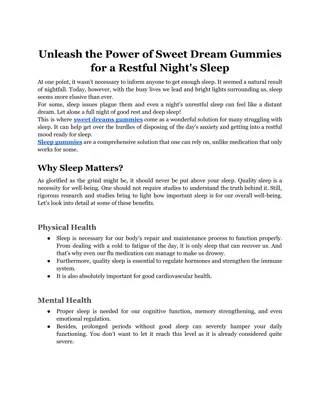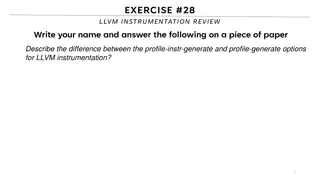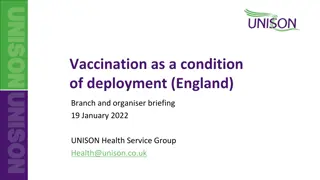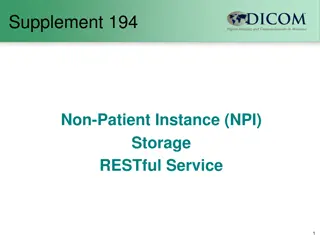Secure RESTful Interface Profile Phase 1 Briefing
Develop a profile for distributed information sharing using the RESTful architecture style. The aim is to demonstrate the viability of this approach through a pilot deployment, ensuring security and compliance with VA requirements. Scope includes secure transport, authentication, and authorization across diverse users. API design and content focus on providing security using open standards like UMA, OpenID Connect, JWT, OAuth, and more.
Download Presentation

Please find below an Image/Link to download the presentation.
The content on the website is provided AS IS for your information and personal use only. It may not be sold, licensed, or shared on other websites without obtaining consent from the author.If you encounter any issues during the download, it is possible that the publisher has removed the file from their server.
You are allowed to download the files provided on this website for personal or commercial use, subject to the condition that they are used lawfully. All files are the property of their respective owners.
The content on the website is provided AS IS for your information and personal use only. It may not be sold, licensed, or shared on other websites without obtaining consent from the author.
E N D
Presentation Transcript
Secure RESTful Interface Profile Phase 1 Briefing Mark Russell Phase 1 Task Lead July 30, 2014 1
2 Background Dr. Paul Tibbits, VA Office of Information & Technology (OIT) Architecture, Strategy, & Design (ASD) Integration with Mission Partners: The VA interoperates seamlessly with mission partners enabled by architectural alignment Modern Open Architecture Technical contributions to accelerate VA use of open standards and open architectures to successfully serve our nation and facilitate mission partner interoperability Mary Pulvermacher Sponsor: Outcome: Task Area: Outcome Lead: Joe Paiva / Tim McGrail, ASD Office of Technology Strategies VA Task POC: Task Summary: Phase 1 - Develop a profile for distributed information sharing using the RESTful architecture style Use open standards Must be secure and compliant with VA requirements Must support lightweight web clients and mobile devices Phase 2 - Demonstrate the viability of this approach through a pilot deployment
3 Secure RESTful Interface Profile Scope How to provide: Secure Transport Authentication Authorization Across a diverse population of: Users .gov/.mil partners Commercial organizations Veterans Citizens Client software Web services Native apps Browser apps For external RESTful Interfaces, using open standards
4 Scope, continued API Design & Content Not In Scope Authorization Authentication In Scope Transport Security API content and messaging are not in scope REST APIs such as HL7 FHIR* do not (and should not) dictate particular security mechanisms Security elements can be layered over many different APIs serving different kinds of use cases * Health Level 7 Fast Healthcare Interoperability Resources: http://www.hl7.org/implement/standards/fhir/
5 Open Security Standards for RESTful Interfaces A stack of interrelated protocols in wide use on the web can help meet security requirements for RESTful interfaces UMA (User-Managed Access) OpenID Connect (Identity Federation) JWT (Secure Tokens) OAuth (Authorization) JOSE (Signed & Encrypted Data) JWK JWS JWE JWA TLS (Secure Transport) Acronyms: TLS: Transport Layer Security JWE: JSON Web Encryption JSON: JavaScript Object Notation JWA: JSON Web Algorithms JWK: JSON Web Key JOSE: JSON Object Signatures & Encryption JWS: JSON Web Signature JWT: JSON Web Tokens
6 RESTful Security Patterns The Use Cases document outlines three patterns for REST security: Client Delegation, using OAuth 2.0 Identity Federation, using OpenID Connect 1.0 VA as Relying Party (RP) VA as OpenID Provider (OP) Profiles and security guidance for OAuth and OpenID Connect will be developed to support VA use of these patterns
7 Client Delegation Pattern Examples: A veteran delegates access to his/her Electronic Health Record (EHR) to a web application for tracking blood pressure A veteran delegates access to his/her EHR to a mobile application, limiting the scope of access to information pertaining to a particular medical condition A veteran uses a personal health monitoring device which uploads measurement data to an external web application; the veteran delegates access to the web service to upload this Patient- Generated Data (PGD) to a VA system
8 Client Delegation with OAuth 2.0: Authorization Code Flow Authorization Code Flow 1. User interacts with client & initiates request for protected resource at VA 2. Client redirects user agent to AS with authorization request 3. User authenticates & authorizes client access 4. Authorization Server redirects user to Client with an Authorization Code (AC) OK! Access Authorization Code Token Refresh Token 5. Client submits AC & client credentials to AS s Token Endpoint 6. AS validates AC. If valid, AS issues Access Token (AT) and optional Refresh Token (RT) 7. Client accesses Protected REST API, passing AT as proof of authorization Access Token 8. Client can use optional Refresh Token to obtain a new Access Token when AT expires
9 Federation (VA as Relying Party) Pattern Examples: A VSO employee authenticates to a VA system through an OP operated by the VSO organization A specialist authenticates to a VA system through an OP operated by the external health care provider organization in order to view the EHR of a referred patient A pharmacy employee authenticates to a VA system through an OP operated by the pharmacy to upload veteran immunization records Veterans authenticate through the OP of their choice as an alternative to DS Logon
10 Federation (VA as Relying Party) Pattern: OpenID Connect 1.0 Authorization Code Flow 1. Unauthenticated user attempts to access protected resource at VA 2. VA Relying Party (RP) redirects user to OpenID Provider s (OP) Authorization Server (AS) with an Authentication Request OK! Authorization Code Access Token 3. User authenticates to AS & authorizes the RP to access identity information ID Token 4. AS redirects user to RP with an Authorization Code (AC) 5. RP authenticates to the OP and submits the Authorization Code 6. OP validates Authorization Code and issues ID Token and Access Token 7. RP extracts user identity and other claims from ID Token 8. If additional claims are needed, RP requests them from OP using the Access Token for authorization
11 OAuth Attack Categories and Countermeasures Attack Category Countermeasures Extracting credentials or tokens in captured traffic TLS encryption Impersonating authorization server or resource server TLS server authentication Manufacturing or modifying tokens Issue tokens as signed JWTs Redirect manipulation Require clients to declare redirect URIs during registration Guessing or interception of client credentials Used signed JWTs for client authentication Client session hijacking or fixation Use the State parameter to ensure continuity of client session throughout the OAuth flow
12 Profiling Security Standards Examples from the OAuth 2.0 Profile An access token is a string representing an authorization issued to the client. The string is usually opaque to the client. Access tokens can have different formats, structures, and methods of utilization (e.g., cryptographic properties) based on the resource server security requirements. complete redirection URI The authorization server SHOULD require all clients to register their redirection endpoint prior to utilizing the authorization endpoint. The authorization server SHOULD require the client to provide the RFC6749 The OAuth 2.0 Authorization Framework The server MUST issue tokens as JWTs with, at minimum, the following claims Clients using the authorization code or implicit grant types MUST register their full redirect URIs. The Authorization Server MUST validate the redirect URI given by the client at the authorization endpoint using strict string comparison. The access tokens MUST be signed with JSON Web Signature (JWS). The authorization server MUST support the RS256 signature method for tokens and MAY use other asymmetric signing methods. Secure RESTful Interface Profiles for OAuth 2.0
13 Next Steps Phase 2 of the Secure RESTful Interface Profile Project Collaborating with VHA & ONC on potential pilot integration Next steps towards VA adoption of the profiles and security guidance: Host additional discussions with VA stakeholders Sponsor discussions with external parties Perform technical integration analysis Plan for client developer support Define client standards and registration process, and make them transparent Incorporate REST standards profiles and other guidance into EA Questions Identified: Need for common agreement on how to pass authentication context between VA and its partners Need consensus on assurance requirements for common health use cases Federal policy regarding system interconnections needs more clarity
14 Potential Future Work Advanced OAuth security options identified in the OAuth profile Client authentication to protected resources, proof of possession tokens User-Managed Access (UMA) Promising protocol for patient consent management technology not quite ready for production use, but actively being pursued by ONC Feasibility of including this in Phase 2 pilot activities is in question
15 Backup Slides
16 Approach Inputs Task Work Products Use Cases and Distributed Security Requirements Approach Briefing Standards Profiles Pilot Implementation Secure RESTful Interfaces Profile PHASE 1 Identify use cases Analyze requirements Define standards profiles Document security guidance VA Security Policies Standards Documents Ongoing Collaboration & Feedback PHASE 2 Identify pilot use case(s) Coordinate implementation with VA Implement pilot Update documents based on lessons learned Existing Profiles BlueButton+
17 Secure RESTful Interface Profile Work Products Secure RESTful Interfaces: Business-oriented Use Cases & Associated Distributed Security Requirements (5/16/14) Describes three RESTful Security patterns with relevant use case examples Describes a potential future pattern based on User-Managed Access (UMA) Secure RESTful Exchange Approach Briefing (6/12/14) Draft Open Standards Profiles (6/30/14) Profiles of OAuth and OpenID Connect applicable to a wide range of VA use cases Includes advanced security options for high-assurance use cases Secure RESTful Interface Profile Security Analysis and Guidance (7/28/14) Security analysis of OAuth 2.0 and OpenID Connect 1.0 Rationale for profiling decisions Analysis of applicable VA and Federal policies and potential impacts Next steps and identified issues
